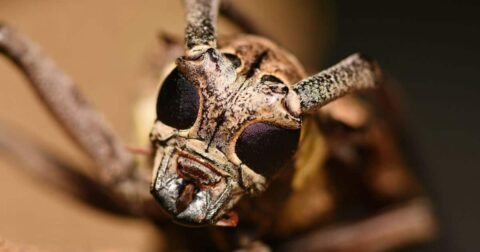Explainer
Animals Can Work Together, and Here Are a Few Notable Examples
Research•8 min read
Explainer
The term means different things to different people, but here’s what you need to know.


Words by Björn Ólafsson
Animal rights advocates frequently say that animals deserve to be free from pain and suffering for this reason — because they are sentient. Advocates of fishing and farming may claim the opposite. But what does it mean to be sentient anyway? It’s a surprisingly complex word, one that can carry different definitions in different contexts, which can make the debate on animal rights especially complex.
Let’s dive into the history and implications behind this crucial concept.
The concept of sentience differs based on the organization defining it. The word originally comes from a Latin root meaning “to perceive” or “to feel.” The dictionary defines sentient as “feeling or sensation,” while the American Psychology Association defines it as “capable of sensing and recognizing stimuli.”
Philosophers have been debating the existence of sentience for millennia. While Descartes decreed that animals don’t have minds, philosophers have since been arguing for the existence of animal sentience — leading utilitarian Jeremy Bentham to famously say: “The question is not, Can they reason? nor, Can they talk? but, Can they suffer?” These questions quickly formed a branch of philosophy called sentiocentrism or sentientism, which argues that any being capable of suffering deserves moral value. Famous proponents of this ethics system include animal rights defenders and philosophers Peter Singer, J . Howard Moore and Tom Regan.
Scientists only have a vague notion of sentience, often defining it in slightly different ways; there is no single method of determining whether or not a being is sentient. Instead, scientists approach the problem in two primary ways: assessing body language, heart rate and physiological factors, or looking for the existence and prevalence of neurons.
The concept of sentience is expansive in many religions, especially Eastern religions. Sentience is a central tenet to Jainism, whose followers believe that animals have senses and souls, leading them to non-violent practices towards all living beings. In Tibetan Buddhism, “sentient”could be translated to “gro ba, which means ‘to go,’” writes Buddhist monk Mattieu Ricard, towards “that which is favorable and away from that which might be harmful.” Animals are considered sentient beings in Buddhism, Hinduism and more.
Many Indigenous cultures have expansive views of sentient beings, which sometimes include inanimate objects or places. In particular, land, with which Indigenous peoples have complex, ancestral relationships, can be considered sensing or even alive itself. This leads many Native groups to abstain from the concept of land “ownership,” as one should not own a sentient being.
Like any complex psychological-philosophical term, the word “sentient” can mean different things when used by different groups of people.
In science fiction, the word “sentient” can indicate an ability to reason or think (picture an artificially intelligent robot from an Asimov book). As AI increasingly nabs headlines, both programmers and journalists sometimes use AI’s potential capacity for consciousness and the term sentience interchangeably.
Even scientists have used different definitions of sentience: two entries in the Encyclopedia of Animal Behavior define it as either “the capacity to have feelings” or the “depth of awareness an individual possesses.” The lines between “sentience”, “consciousness”, and “sapience” (capable of wisdom) are often blurred. Thankfully, scientists are starting to coalesce around a shared terminology. The Sentience Institute, a non-profit research organization dedicated to questions like these, would define sentience as the “capacity to have positive and negative experiences.” Researchers are driving the field of animal studies even further, giving more proof to the idea that animals feel pain, and that many species may be capable of introspection.
“The Sentience Quotient,” a term invented by Robert Freitas and published in 1984 in a science fiction journal, was originally meant as a tool for considering the intelligence of beings beyond Earth. The Sentience Quotient is measured quantitatively, based on the “amount of data [an intelligence] can process per unit time” and “the overall mass needed to do that processing.”
This is an example of “sentience” being confusing, as the test is more similar to concepts of sapience or intelligence than sentience. The Sentience Quotient is not considered a valuable measure of a creature’s ability to suffer or feel pain and should be thought of more as a thought experiment.
Any being capable of feeling pain and pleasure is considered sentient.
Consciousness is the state of being aware of something within oneself. It’s that knowledge that says, “I am a being, I exist.” Sentience, as defined above, is only about the capacity to feel pleasure and pain. Consciousness is even more difficult to prove than sentience; according to some philosophies, it is completely impossible to prove at all. Even so, the majority of scientific research supports the existence of consciousness in many, many species of animals.
No, by all definitions of sentience, and according to the scientific community, humans are far from the only creatures who feel pleasure and pain.
The vast, vast majority of animals are sentient. This includes animals we may not think twice about, like bees buzzing around your head or the tiny fish in a neighborhood pond. There are a few potential exceptions — some creatures like sponges and jellyfish, who have a “neural net” instead of a brain, may not feel pain — although not enough research has been done on this front.
Even with these potential exceptions, most members of the Kingdom Mammalian are sentient.
Most marine animals are sentient. Most obviously, dolphins, whales and other mammals are bright, social and clearly sentient creatures. But fish are also well-documented asable to feel pain. These creatures, who are farmed in excess of one trillion every year, can feel pleasure, communicate with others and, of course, suffer. Even oysters, who lack brains but have neurons, are likely capable of feeling pain.
No, by nearly all definitions of the word, plants could not be considered sentient. They are able to respond to stimuli, absolutely, but they lack nerves or a central processing system that would allow them the ability to “feel” — the critical component of sentience.
It’s simple — if a creature is capable of suffering, we should avoid causing it to suffer as much as possible. Beating a dog is considered wrong not because it’s illegal, but because we can recognize the dog is feeling pain, and unnecessary pain is unethical.
The knowledge that most animals are sentient can be existentially difficult to take in — if the bug you accidentally squashed earlier today felt pain during his death, what does that mean about you? In fact, we humans have psychological mechanisms in place to prevent us from thinking too deeply about animal sentience at all.
But, to many philosophers, this isn’t a question we can just skip over. Animals are denizens of the Earth too, and if they are capable of feeling pain, this implicates the human systems that inflict suffering upon them.
For many animal activists, the concept of sentience is central to their advocacy. Peter Singer, an academic and prominent defender of animal rights, believes that because almost all animals are sentient, we should treat their lives with worth and dignity and never inflict pain upon them. This leads him to veganism, the belief of avoiding animal products and exploitation in one’s everyday life.
Animal rights, which is distinct from animal welfare in that it opposes all forms of exploitation, not just maltreatment, is also founded on principles of sentience.
Philosopher Gary Francione differs from the philosophy of Peter Singer by arguing that animals’ sentience should give them freedom from humans, not just freedom from specific pain. It’s not just factory farms that cause suffering to animals, but their position in a system that values them as property, not as beings.
As the research into animal sentience expands every year, it has begun to influence federal animal welfare protection across the world. Countries are passing legislation limiting animal testing, U.S. states are expanding the size of cages for farmed animals, and harmful hunting practices like whaling are being slowly phased out. These laws often follow research into animal sentience, or reports from animal welfare specialists.
Going forward, this trend is likely to continue. Conferences discussing animal sentience began in 2019, and workshops, think tanks and science groups are all dedicated to uncovering more about this critical topic. The research is only going to continue.
The knowledge that most animals are sentient can be a tough existential pill to swallow, especially when we use farming systems that exploit animals and undoubtedly cause them immense pain. There are also trillions of insects, fish and other invertebrates we may not think twice about who are also capable of pleasure and suffering.
You may be one of many who feels compelled to abstain from animal products given the breadth of scientific evidence of their pain. For many philosophers and everyday people, this is the only ethical outcome of decades of research.